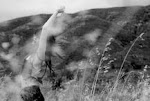
Argentine singer, Andrés Calamaro, wrote this song called "One can't live just from love"
I bought this great book by Walter Riso "A Guide to Avoid Dying from Love. Ten Principles of Emotional Survival". I found it tough yet excellent. A short and perhaps interesting read for those who say you can work out relationship- related problems on your own and that getting psychological help has never crossed your mind.
I may be wrong, but I checked and did not find a version of this book in English, so I’m quoting some interesting points I found. I hope it helps those who are looking for a relationship, those who are already in one and all you love birds who may be thinking of ways of making your love life even better.
"Feelings do not cover everything in a relationship. Specialists say that 'Love isn't enough' and they may be right. Our choice of a couple should be more thought out and less visceral: "I like a lot of things in you, I want you, but I am still not sure weather you fit in my life or not, even though my body and my being push me towards you in a confusing way'. I am sorry for love fans but for people who live in an earthly world and have not transcended yet, love isn't usually that unconditional (the amount of deserters in the subject gets bigger every day) nor it moves mountains, if you don't pay enough attention to it, if you don't know how to handle it, it crushes you, it overwhelms you.
You should put your enthusiasm aside for a moment, before making a blind decision and connect to a more controlled processing system (I am saying you can stop being so hippomaniac or in love for a few moments, you can try to relax voluntarily). Once you have arrived back on earth, you should consider the advantages and disadvantages, pros, cons and expectations and try to see reality as it is (not blinded by love). This, will allow you to, in the future, be able to integrate feelings, reality and emotions and to realize when one is missing or excessively present.
Functional and healthy couples love freely (they are able to use their own time however they please), in a non possessive way (no one belongs to the other) and without the need for the other to be present at all times (they can be on their own, do their own thing). If you are capable of deciding about your own timing, if you don't feel you are 'owned' by someone and at the same time you feel you can walk through life on your own, you have entered the grounds of mature love.
A good relationship requires at least three factors to work at the same time: desire / attraction; friendship and tenderness. If your relationship is lacking one of those components, it could be going down hill. Analyze them and make your own decisions.
The following, is a phrase by Stendahl that has always caused a great impact on me because of its beauty and realism: 'Love is a very beautiful flower but you have to have the courage to go look for it at the edge of an abyss.'
In love you sweat, you fight, you make up, you create day by day. If you are a very romantic person, you will have a minimal resistance to the hardships love brings.
Some think that love causes suffering, others are naïf enough to believe in the ingenuity of romantic love. Realistic love, however, may be half way between those two poles. Love, in a relationship, isn't always a fairy tale though some insist on calling it that. It brings good and bad times, you will have to learn to deal with.
If behaviors and negative attitudes go over the limit, you will have to jump; if there is respect within what is acceptable and feelings are sponsored by solid love, you go on in your relationship. Love grows and develops.
Post by: Valeria Méndez Cañas








































